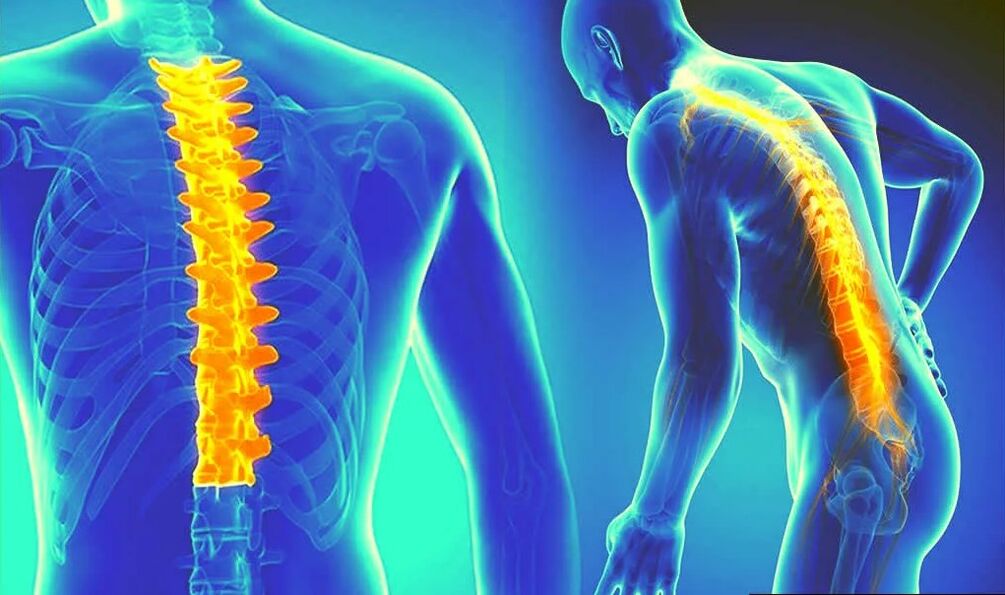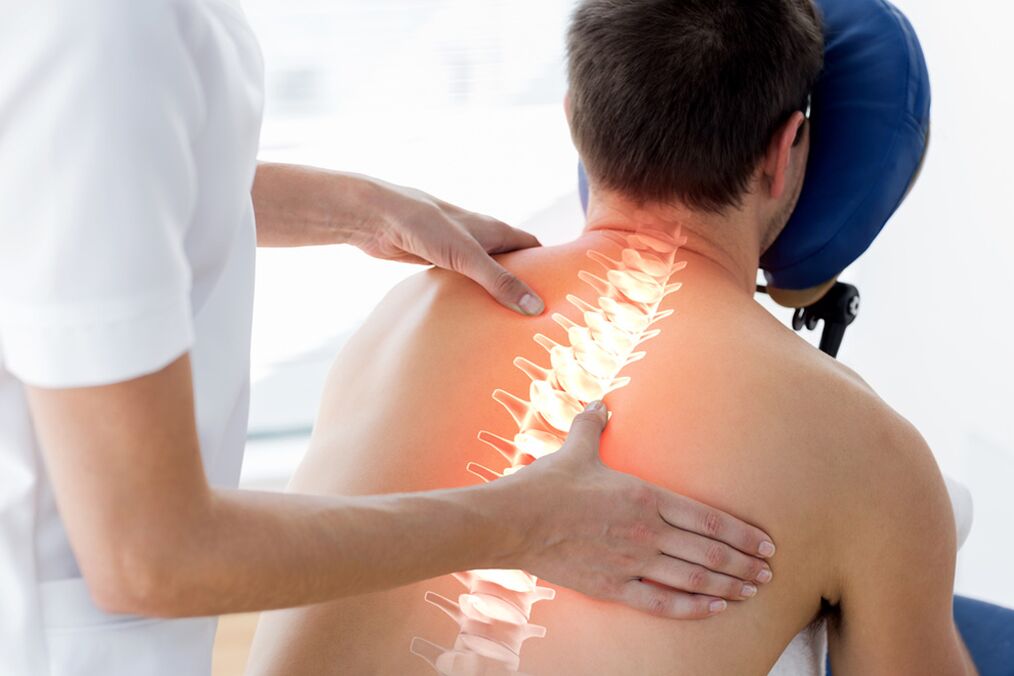Osteochondrosis is referred to as a pathological process in the cartilage of the intervertebral disc and nearby tissues. The disease can occur in any part of the spine, however the cervical spine is more susceptible to osteochondrosis. This is due to the anatomical features of the body. The vertebrae in the neck are smaller than those found in the thoracic and lumbar regions and are very close to each other. In addition, the neck is characterized by increased mobility and experiences normal stress while holding the head.

Why does the disease appear
The development of this disease is mainly related to changes due to age. Other reasons are noted:
- lack of physical activity;
- spinal diseases;
- overload;
- incorrect posture;
- bad offspring;
- weight gain;
- autoimmune disorders in which cartilage is damaged.
The condition of bone and cartilage tissue is severely affected by nutrition. The development of pathology is facilitated by a diet with a lack of calcium, phosphorus, zinc, magnesium, vitamins A and E, vitamin D. High -risk groups include office workers, professional athletes, people engaged in physical hard work.
How to identify cervical osteochondrosis
The symptoms of the disease depend on the clinical case and its stage of development. The most common signs are:
- pain that affects not only the neck and head, but also other parts of the body;
- weakness, decreased hand sensitivity, numbness of the face;
- pain in the neck when you have to turn the body;
- dizziness, weakness, darkness in the eyes caused by pinched blood vessels;
- visual and hearing impairment.
Pain in cervical vertebral osteochondrosis bothers almost all patients. With pathology, the ducts, bundles of nerve endings in the neck area are pinched. As a rule, pain is most felt in the area of the head, occiput, shoulders, and radiates to the scapula and chest.
Against the background of this disease, the heart rhythm may be disturbed. In the neck area, there are several arteries responsible for the supply of blood to the brain. When blood vessels pinch, patients face problems such as impaired coordination of movements, arrhythmias, and ischemic heart disease. In severe cases, blockage of blood circulation causes stroke and other life -threatening conditions.
The stage of the disease
The development of the disease is divided into four stages:
- In the early stages, new bone and cartilage tissue begins to break down. The pathology manifests itself as slight pain and fatigue, which the patient associates with stress.
- In the second stage, there is a drop of the disc, the appearance of cracks. The pain increases, there may be numbness on the face and decreased sensitivity of the limbs.
- In the third stage, an intervertebral hernia begins to form. The process affects muscles and blood vessels. The patient not only experienced pain, but also dizziness.
- In the last stage, bone tissue growth occurs, nerve endings are pinched. The disease manifests itself with obvious symptoms: pain, dizziness, numbness. Many patients experience impaired motor activity.
Diagnostics
If you suspect cervical osteochondrosis, the patient should see a neurologist and undergo a diagnosis. Its job is to assess the condition of bone and cartilage tissue. Previously, x-rays were used to diagnose spinal diseases. Now priority is given to more advanced research methods:
- CT scan;
- MRI;
- duplex scan of the cervical spinal canal.
Often, the doctor prescribes a thorough diagnosis. This allows you to determine the presence and location of the hernia, the velocity of blood flow, the presence of obstructions to normal blood circulation.
Treatment
A patient diagnosed with cervical spine osteochondrosis needs to reconsider his or her lifestyle, ensure regular physical activity, and eat properly. To improve the condition, it is recommended to sleep on an orthopedic mattress and comfortable pillows to relieve pressure from the spine.
Medications
With cervical osteochondrosis, patients are shown medications that relieve inflammation, improve blood flow, and reduce pain. Doctors prescribe drugs for vasodilation, muscle relaxants, non-steroidal anti-inflammatory drugs, drugs to improve cerebral circulation, chondroprotectors-ways to restore cartilage tissue. To slow the damage of bone tissue, the body needs B vitamins, calcium, phosphorus, magnesium, niacin.
Physiotherapy

Physiotherapy is the main method of treating osteochondrosis of the cervical spine. Specialists use many procedures, the task of which is to improve metabolic processes in bone and cartilage tissue, reduce pain, relieve cramps and improve blood circulation. Here are the basic techniques:
- Shock wave therapy. . . Low -frequency acoustic waves affect the cartilage tissue of the cervical spine. They contribute to tissue recovery, slowing the formation of osteophytes - growths on the bone that squeeze nerve endings and blood vessels. Low frequency wave sources are special devices, therefore, SWT courses can only be taken in medical institutions.
- Sort. . . This is the most common method of conservative therapy for cervical osteochondrosis. Massage helps improve blood circulation, relieves muscle spasms. The massage therapy technique chosen depends on the stage of the disease and the clinical picture. This is a very important condition, because if the massage is done unprofessionally, it can endanger the patient, causing a deterioration of well -being. Need to give massage treatment for vascular diseases, high blood pressure. During suffering, massage is as simple as possible. Caressing, rubbing is allowed, that is, it affects the top layer of tissue.
- Therapeutic gymnastics (exercise therapy). . . Exercise therapy helps strengthen muscles and improve blood circulation. There is a special set of exercises for patients with osteochondrosis. Gymnastics can be done not only in the offices of medical institutions, but also at home. As a rule, exercise therapy is most effective during the remission period, when the patient does not feel severe pain. Health training should be combined with walking procedures, water.
- Acupuncture. . . This is an additional method for the treatment of osteochondrosis, which is based on the effect of a special needle on a biologically active point. Thanks to this, metabolism is activated, pain syndrome is reduced.
- Kinesitherapy. . . This is a hardware technique used to treat spinal diseases, recovery after injury. Thanks to the exercise, the load is removed from the spine, its movement is improved, and blood circulation is restored. Kinesitherapy classes are conducted under the guidance of instructors. There are many methods and tools for doing exercises, therefore, an appropriate set of exercises is selected for each patient.
- Laser therapy. . . Thanks to laser radiation, a positive effect is achieved, the well -being of the patient is improved. This procedure reduces inflammation and pain, and has a positive effect on metabolic processes.
- Electrotherapy. . . Specialists use devices that are a source of galvanic, pulsating, alternating current. The purpose of the procedure is to reduce pain, relieve cramps, and stimulate.
- Water procedure. . . Water is the best remedy for osteochondrosis. Patients with this disease are shown therapeutic baths, swimming, underwater massage. Very useful for the prevention and treatment of pathology is a regular visit to the pool.
Surgery for osteochondrosis
Spinal surgery for osteochondrosis is indicated for patients with advanced stages of the disease, where it is not possible to achieve remission by conservative methods. Surgery is used to remove the herniated disc and the affected disc. Also, surgery is performed to widen the diameter of the spinal canal, removing the vertebral arch. The purpose is to relieve stress on the nerves and spinal cord, which allows you to get rid of discomfort.
All manipulations were performed under anesthesia using X-rays and microsurgical control.
For disc protrusion, the laser discectomy method is used. This is a minimally invasive technique that allows you to evaporate the pulposus of the disc nucleus using a laser beam and thus eliminate compression.
Nutrition for osteochondrosis
Improper nutrition increases the risk of developing degenerative-dystrophic diseases of the musculoskeletal system, which includes osteochondrosis. To slow down the pathological process in bones and cartilage, it is necessary to provide the body with adequate amounts of vitamins and minerals. The diet should include:
- dairy products - a source of calcium;
- fresh vegetables and herbs;
- legumes, nuts, seeds - a source of protein, magnesium, B vitamins;
- cereals, toast with the addition of grains;
- lean meats;
- Fish and seafood;
- olive oil and other vegetable oils;
- jelly, meat jelly, jelly dishes.
There are no strict dietary restrictions, but there are foods that are not desirable to be eaten in large quantities. First of all, it is a strong tea and coffee, which interferes with the absorption of calcium and vitamins. Foods high in salt are also not beneficial.























